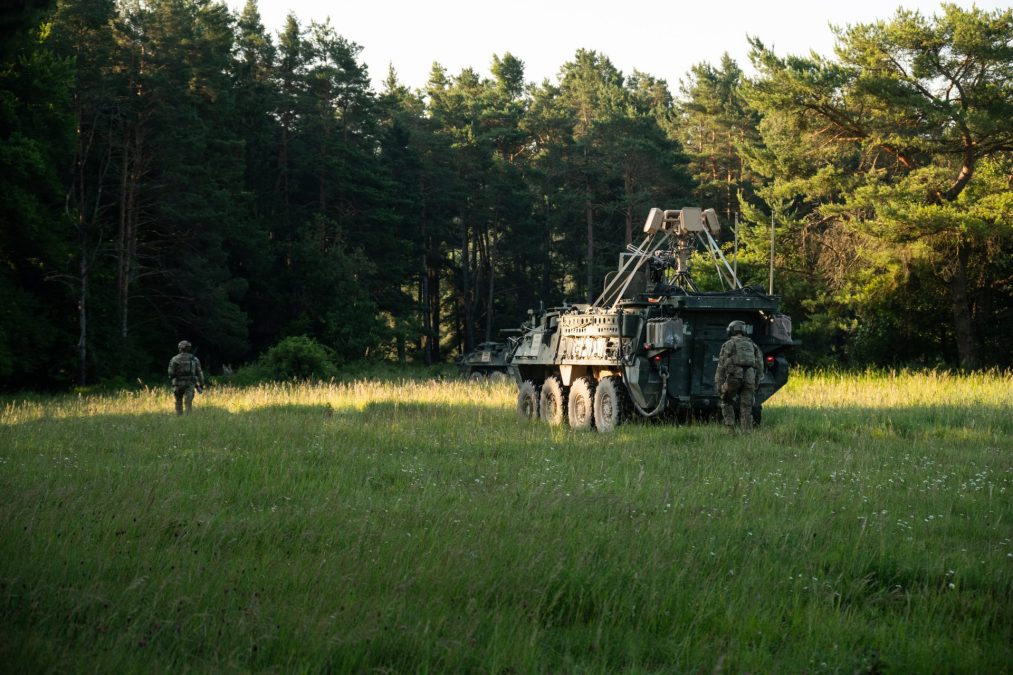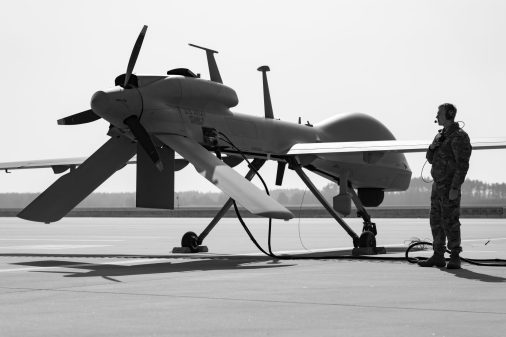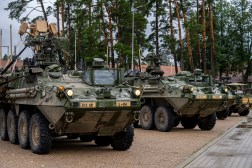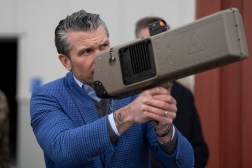Army maturing counter-drone command and control architecture at Project Flytrap exercise

The Army’s science and technology hub, through its own work and collaboration with industry, is developing a command and control architecture to counter drones as well as transition static systems into vehicle-mounted capabilities to defeat threats on the move.
While the organization’s counter-unmanned aerial system (C-UAS) efforts date back several years, the work by the Army Combat Capabilities Development Command’s Command, Control, Communications, Computers, Cyber, Intelligence, Surveillance and Reconnaissance (C5ISR) Center is part of Project Flytrap taking place in Europe.
Flytrap is a joint U.S. and U.K. effort to test new counter-UAS technologies in order to eventually incorporate them into formations. It began in the European theater last month, and may become a standard, yearly exercise, expanding on innovation and experimentation while building on lessons learned, Army officials said.
The event initially sought to bring these technologies down to the squad level and seek to lower the cost per drone defeated through new methods and technologies.
The U.S. military has been behind the cost curve when trying to thwart small drones, using million-dollar missiles to defeat large numbers of inexpensive UAS.
C-UAS has proved to be a difficult problem for the Army and joint force, dating back several years when terrorist and insurgent groups in the Middle East began strapping homemade explosives onto commercial drones and dropping them on troops’ positions.
The problem has grown since then, as evidenced in Ukraine’s war with Russia where first-person-view drones have been a prominent fixture of the fight. Based on its observations, the Army has realized it must up its game to protect its own forces from these types of attacks that will be inevitable in future conflicts.
Part of the problem is there aren’t many commercial C-UAS solutions on the market, akin to the ballooning availability of drones. And even if there were easy counter-drone solutions on the market, the military must knit them together to create a system of systems for thwarting overhead threats through a command and control architecture.
That’s where the C5ISR Center comes in.
“The genesis of it was create a C2 architecture that worked for counter-UAS that included individual soldiers all the way up to our joint partners,” Brandon Dodd, mechanical engineer with C5ISR Center, said in an interview. “How are we going to get data from individual sensors to individual soldiers and then all the way up and over to our partners? How does that look at each level? Where are the hiccups throughout that architecture? That’s where we came in, was we had some projects that were existing in counter-UAS.”
Flytrap aims to not only develop and test counter-UAS technologies and strategies, but inform new tactics for the Army in how to thwart these threats in the future.
The C5ISR Center serves as the Army’s science and technology hub, looking at problems and gaps that exist and beginning research and development through government solutions, at first, to solve them. They then work with industry to proliferate those solutions and get them into the field to soldiers and units.
The work for Flytrap is no different.
The C5ISR Center began by looking at best-of-breed sensors and working to link them up through a command and control architecture through the Army’s Android Tactical Assault Kit, or ATAK, where data from the sensors were shared across the force.
That work started with a set of commercial-off-the-shelf sensors that initially were stationary and tripod mounted.
The team then transitioned those stationary capabilities to vehicle-mounted tools to allow units to sense on the move — a more realistic scenario given these are maneuver units that have to go fast on the battlefield.
“Through rapid innovation, we’ve been able to adapt our sensors and effectors that are traditionally static and turn them into something mobile that fits the needs of the Army. To me, as a former operator, that’s a really big deal to have something that you can actually use when you go outside the wire,” Mike Moore, an engineering technician with the C5ISR Center who has been on the ground supporting Flytrap, said. “We’ve been able to mold the sensors and effectors and infuse them into a way that meets the soldiers’ needs on the ground, using a layered approach to command and control. The layered approaches we found is a necessity. We created one common operating picture using ATAK, something that that soldiers already have, we didn’t invent something new.”
The C5ISR team worked tightly with various industry partners on not only the vehicle integration, but constant software fixes and iteration in real-time with the unit to improve how the system worked based on feedback from troops during the exercise.
“We’ve shown that through some of our sensors that we’ve been able to solve these … lengthy software development problems very rapidly through how soldiers actually use the equipment and the tactics in which they employ them,” Moore said.
The team worked with V Corps and specifically 2nd Cavalry Regiment, initially planning to outfit a platoon but grew to a company element. The exercise has used Strkyers thus far, but the technologies are meant to be platform agnostic and capable across domains, officials said.
There were challenges to adapting a static, stationary sensor system to something that was mobile. Physics constraints posed challenges such as certain acoustic sensors that become more limited when they’re moving. The team at first developed quick fixes with industry to determine how best to employ the sensors in a way that they remain effective and still support maneuver operations.
One of those fixes was a way to pull the sensors off and set them up in a timely manner to provide the coverage needed.
The team developed a couple of different command and control layers — mostly through ATAK — and a variety of sensing modalities for drone detection and one modality for defeating them.
Sensor fusion was developed as to not cognitively overburden soldiers and reduce the amount of information they received. The C2 architecture allowed forces to not be co-located with the sensor and effector in order to use it. Because it was tied to ATAK, forces up and down echelon could track systems and cue the effectors, allowing for distributed command and control.
The government and industry teams were working hand-in-hand on the integration software in near real-time during the exercise.
“In terms of the other sensors where we created a whole new way for this for soldiers to employ them, we worked directly at the exercise with the vendor where we were modifying how our integration software works, how we were displaying things on a C2 system,” Dodd said. “Those things were stuff that we modified on the government side while the vendor actually was modifying their proprietary software on their side.”
Soldiers tested these sensors and systems in realistic environments overseas in almost live-fire scenarios.
“We’ve been able to incorporate realistic scenarios and knowledge of current [tactics, techniques and procedures] to help push these systems in a direction that apply real-world lessons learned. We’re not we’re not just creating something that works. We’re creating something that works in our current environment,” Moore said, adding there was an opposing force going against the unit while it maneuvered.
The next iteration of Flytrap will take place at the end of this month and will focus on conducting counter-UAS operations at the company and battalion-minus level for multi-day missions, according to Army officials. The soldiers will see a faster tempo, more realistic scenario to stress their skills and the systems.
“As we get into the exercise occurring in July, that’s certainly going to ramp up more where there’s even more live threats and it’s even more realistic for what they might see in a place like Ukraine,” Kevin White, global operation support and threat chief at C5ISR Center, said.
Officials noted that the team and unit have gone through the early phases and are hitting their stride through the first couple of iterations.
“Now it’s really, we do have some minor tweaks that we’re going to make from the engineering or technical aspects, but most of it is allowing the soldiers to now utilize what they’ve learned over the last few exercises and employ them while doing their other job,” Dodd said. “Allow a maneuver unit to do their normal mission and then add counter-UAS as the aside, that we see it going to be. Do that and then slowly ramp that up throughout the next exercise so that we stress it to its max while seeing what lessons [were] learned or how they incorporated it to their current mission.”






